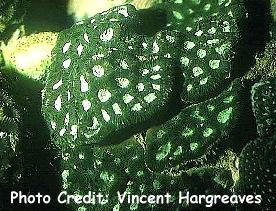
By Bob Goemans

Likely Reef Tank Suitable
Likely Fish-Only Tank Suitable
Range: Indo-West Pacific Ocean: Widespread.
Natural Environment: Inhabits a wide range of environments and usually seen at depths between 6 to 65 feet (2 - 20 m).
General Husbandry: Their common names are similar to those in the genus Favia because they closely resemble them. In fact, their aquarium husbandry is also quite similar.
Occasionally seen in the trade.
As to placement in the aquarium, mid level areas receiving moderate light and somewhat swift water movement is the best initial area. Movement to higher PAR levels only after becoming fully acclimated to initial surrounding conditions is then recommended if brightly colored.
Furthermore, maricultured specimens are available and if brightly colored, ask under what PAR conditions it was grown in so you may continue to see it maintain its health/colors! If unknown, proceed as described above.
Capable of producing its nutritional needs via photosynthesis, yet benefits from once or twice a week feedings of various plankton-like foods, such as Oyster eggs, cyclops, baby brine shrimp, Spirulina, enriched adult brine and mysis shrimp.
Even though its feeding tentacles are usually only displayed at night, it will sometimes display them during daylight hours if it senses food entering the aquarium. I have often used a freeze-dried krill squished between my fingertips in the aquarium water to bring forth its feeding tentacles.
Keep in mind too strong water movement may cause tissue recession, which may in turn bring about a protozoan infestation and also possibly allowing a micro alga such as 'Ostreobium' to infest its barren skeleton material, hastening tissue recession.
Care should also be taken as to its position in the aquarium in relation to other corals, as this species can send out long sweeper tentacles during evening hours.
Feeding tentacles are usually displayed during evening hours and zooplankton-type products such as enriched adult brine shrimp, or Cyclop-eeze can occasionally be offered.
Placement on bottoms substrate is not recommended because sand grains deposits from disturbances can cause tissue damage.
Taxonomy:
Kingdom: Animalia
Phylum: Cnidaria
Class: Anthozoa
Subclass: Hexacorallia
Order: Scleractinia
Family: Faviidae
Genus: Favites
FYI: In the wild, forms small massive-shaped colonies that are either rounded or somewhat hilly having rounded corallites with thick walls, and usually pale brown with brown or green oral discs.
Experience Level: Beginner
Diet: Photosynthetic/Plankton feeder
Temperament: Aggressive
Aquarium Environment: Reef or fish-only aquarium
Coral Safe: With caution
Fish Safe: Yes
Invertebrate Safe: Yes
Acclimation Time: 30 minutes+
Aquarium Hardiness: Moderately hardy
Calcium (Ca): 380 - 430 mg/l
Alkalinity: 2.5 - 3.0 meq/l
Phosphate (PO4): <0.05 mg/l
Magnesium (Mg): approx. 1350 mg/l (relate to specific gravity)
Strontium (Sr) 8 - 10 mg/l
Temperature Range: 74 - 83°F (23 - 28°C)
Minimum Tank Size: 50 gallons
Lighting: PAR 350 - 450+
Water Movement: WM 2
Specific Gravity: 1.023 - 1.025
pH: 8.0 - 8.4
Iodine/Trace Elements Monitor/as necessary to maintain quality seawater.

.jpg)